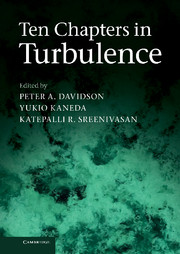Book contents
- Frontmatter
- Contents
- Preface
- Contributors
- 1 Small-Scale Statistics and Structure of Turbulence – in the Light of High Resolution Direct Numerical Simulation
- 2 Structure and Dynamics of Vorticity in Turbulence
- 3 Passive Scalar Transport in Turbulence: A Computational Perspective
- 4 A Lagrangian View of Turbulent Dispersion and Mixing
- 5 The Eddies and Scales of Wall Turbulence
- 6 Dynamics of Wall-Bounded Turbulence
- 7 Recent Progress in Stratified Turbulence
- 8 Rapidly-Rotating Turbulence: An Experimental Perspective
- 9 MHD Dynamos and Turbulence
- 10 How Similar is Quantum Turbulence to Classical Turbulence?
- References
5 - The Eddies and Scales of Wall Turbulence
Published online by Cambridge University Press: 05 February 2013
- Frontmatter
- Contents
- Preface
- Contributors
- 1 Small-Scale Statistics and Structure of Turbulence – in the Light of High Resolution Direct Numerical Simulation
- 2 Structure and Dynamics of Vorticity in Turbulence
- 3 Passive Scalar Transport in Turbulence: A Computational Perspective
- 4 A Lagrangian View of Turbulent Dispersion and Mixing
- 5 The Eddies and Scales of Wall Turbulence
- 6 Dynamics of Wall-Bounded Turbulence
- 7 Recent Progress in Stratified Turbulence
- 8 Rapidly-Rotating Turbulence: An Experimental Perspective
- 9 MHD Dynamos and Turbulence
- 10 How Similar is Quantum Turbulence to Classical Turbulence?
- References
Summary
The wide ranges of length and velocity scales that occur in turbulent flows make them both interesting and difficult to understand. The length scale range is widest in high Reynolds number turbulent wall flows where the dominant contribution of small scales to the stress and energy very close to the wall gives way to dominance of larger scales with increasing distance away from the wall. Intrinsic length scales are defined statistically by the two-point spatial correlation function, the power spectral density, conditional averages, proper orthogonal decomposition, wavelet analysis and the like. Before two- and three-dimensional turbulence data became available from PIV and DNS, it was necessary to attempt to infer the structure of the eddies that constitute the flow from these statistical quantities or from qualitative flow visualization. Currently, PIV and DNS enable quantitative, direct observation of structure and measurement of the scales associated with instantaneous flow patterns. The purpose of this chapter is to review the behavior of statistically-based scales in wall turbulence, to summarize our current understanding of the geometry and scales of various coherent structures and to discuss the relationship between instantaneous structures of various scales and statistical measures.
Introduction
Wall-bounded turbulent flows are pertinent in a great number of fields, including geophysics, biology, and most importantly engineering and energy technologies where skin friction, heat and mass transfer, flow-generated noise, boundary layer development and turbulence structure are often critical for system performance and environmental impact.
- Type
- Chapter
- Information
- Ten Chapters in Turbulence , pp. 176 - 220Publisher: Cambridge University PressPrint publication year: 2012
References
- 9
- Cited by

